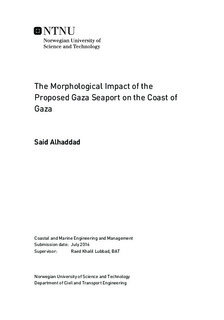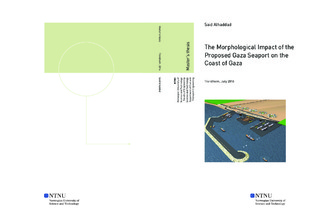| dc.description.abstract | Palestinians in Gaza Strip are in dire need of a commercial seaport to connect Palestine to the World, to enhance the economy and local industry. In 1996, the design of Gaza Seaport was completed, planned to be constructed in the south of the coastal village Elsheikh Ejleen. However, no construction took place to this day due to political issues between Palestine and Israel.
Hard engineering works in the coastal zone usually result in adverse impacts on the coastal system, especially on the morphology. When new structures are constructed, longshore sediment transport becomes an issue. The structures interfere with the natural longshore movement of sediments, leading to coastal erosion and accretion, which changes the shape of the coastline. Consequently, maritime structures need to be adequately planned in order to mitigate adverse impacts on coastal morphology. In addition, thorough insight into the morphological change resulting from such interventions on the coast is necessary to enable adequate planning. This study aims to predict the effect of the proposed Gaza Seaport on the morphology of the coast of Gaza. The effect of the Seaport on the morphology shall be investigated with the incorporation of the numerical models, MIKE 21 and LITPACK, developed by DHI.
MIKE 21 is a two-dimensional mathematical modelling system with a wide range of coastal engineering applications. It is used mainly in this study to model flow, waves, sediment transport and morphological change in the vicinity of the seaport. LITPACK is a one-dimensional coastal processes modelling system. It is used mainly in this study to compute littoral sediment transport and predict coastline changes after the construction of the seaport. Results from MIKE 21 ST show that accumulation of sand will take place inside the seaport basin, in the seaport navigation channel and in the sheltered area ahead of the breakwater. In addition, erosion will take place downdrift of the seaport and scour will take place at the tip of the breakwater. Results from LITPACK can be summarized in three points:
The coastline shape will change considerably in the vicinity of the seaport.
Accretion will take place updrift of the seaport and erosion will take place downdrift of the seaport which is in agreement with the results obtained from MIKE 21 ST.
The shadow length of the breakwater is large enough to block the total amount of littoral sediment transport, 1.23×106 m3/year.
The findings of this study provide some implications for the future development of the seaport. Mitigation measures are needed to maintain the existing beach alignment, prior to the seaport construction. One solution could be beach nourishment and/or a sand bypass system, which would transfer accumulated sand updrift of the seaport to the affected areas in the downdrift side. It should be kept in mind that any solution should take into consideration several stakeholder groups that will be affected by the anticipated situation along the coast. The predicted process of sediment transport in the vicinity of the seaport necessitates dredging the seaport navigation channel in the future to maintain its navigable depth. In addition, the breakwater designer should incorporate scour protection into the design to keep the breakwater stable.
Coastal field measurements are very rare in Gaza Strip due to the poor political situation. Absence of sufficient field data has resulted in this study making several assumptions and performing a sensitivity analysis of longshore sediment transport at the site of interest. The basic concept behind the sensitivity analysis is to provide a starting point for further research that can be continued based on the results obtained in this study. The sensitivity analysis shows that bed roughness is significantly crucial in the calculation of longshore sediment transport and can be considered as the basic calibration parameter in LITDRIFT. Results show that increased bed roughness results in less longshore sediment transport. However, increased wave height and increased wave period result in more longshore sediment transport. | |

